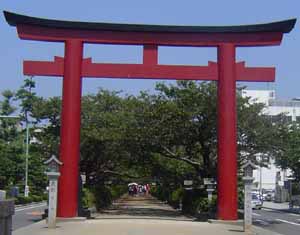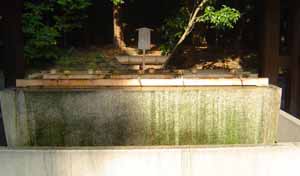 |
|||||
 |
|||||
 |
|||||
 |
|||||
 |
|||||
 |
|||||
 |
|||||
 |
|||||
 |
|||||
 |
|||||
 |
|||||
 |
|||||
 |
|||||
 |
|||||
Shinto Shrine Guide |
|
||||||||||||||||||||||||||||||||||||||||||||||||||||||||||||||||||||||||||||||||||||||||||||||||||
Explanation | Features | Types of Shinto Shrines | How to Visit
Shinto shrines have certain characteristics to them. There are staple buildings and features. This page will attempt to explain those things and show them with pictures from various shrines in Japan. It will also offer a guide in how to attend a shinto shrine.
Typical
Features of Shinto Shrines and Pictures of them. |
|
|
The approach and entrance to the shrine is marked by one or more torii. While most torii are made of wood, they can be made of other material and need not be painted the customary orange and black. At right is a torii marking a cherry tree lined walkway to the Tsurugaoka Hachimangu in Kamakura. |
 |
|
On either side of a shrine entrance, there is often a pair of guardian animals. Usually the animals are dogs, lions or foxes. A set of fox guardians signify a Inari Shrine. They are called the Komainu. At left is one of the guardian lions from the Itsukushima Shrine from Miyajima Island approximately 30 minutes south of Hiroshima |
|
Near the entrance of the shrine is a fountain to be used for purification. Before approaching the main hall one should stop to clean his/her hands and mouth. The purication fountain at right is from The Meiji Jingu Shrine in Tokyo. As this particular fountain is, they are housed in their own open-air building. |
 |
 |
|
|
|
 |
Ema At shrines there are wooden plates that visitors can write their wishes on. They then leave them at the shrine with the hope that their wishes will come true. The most common wishes include good health, success, school exams, love or wealth. The tree at right is from the Meiji Jingu Shrine in Tokyo. The ema are hung on a fence around the base of the tree. |
|
Omikuji
|
|
Shimenawa A shimenawa is a straw rope with white zigzag paper strips called gohei. Wherever there is a shimenawa, there is something sacred. Often they hang from torii, in front of shrines, in front of sacred trees or other objects. The picture at right is of the shimenawa in front of the Wakamiya Shrine at Tsurugaoka Hachimangu in Kamakura. The highest ranking sumo wrestlers or yokozuna will wear a similar rope at ritual ceremonies. |
|
Sake Offerings One of the other common structures that can be seen at shrines the area that houses sake offerings. Sake is traditional rice wine. Sacred sake, known as omiki, is offered in order to appease Aramitama (the wild energy) and thank Nigimitama (the peaceful energy) in one of many rituals which are designed to balance the two forces. The sake offerings at left are from the Yasaka Shrine in Kyoto. |
|
|
Some of the other buildings could include a house for priests and storehouses. One thing you will not see at a shinto shrine is a cemetery. Death is seen as a cause of impurity. |
|
There are different types of shinto shrines. The following chart will explain the different types.
Types
of Shinto Shrines |
|
| Imperial Shrines (Jingu or Jinja) | These
are directly funded by the government and are dedicated to the imperial
family. One of the most famous modern of these is Meiji Jingu Shrine
in Tokyo which is featured on this page. |
| Inari Shrines | These are dedicated to the god or kami of rice. Fox statues guard these shrines due to the fox's connection to the god as his messenger. |
| Hachiman Shrines | These
are dedicated to the god of war. They are obviously most popular with
the military class. Tsurugaoka Hachimangu which is pictured on this
page, is one of the most famous. |
| Tenjin Shrines | These
shrines are dedicated to a Heian scholar and politician named Sugawar
Michizane. For obvious reasons, students will often pray there for success
on exams. They are easily recognized by their ox statues and Michizane's
favorite tree, the plum tree. |
| Clan Shrines | Individual clans have shrines dedicated to them . |
| Local Shrines | Local areas have individual shrines dedicated to |
When visiting a shrines, one should always behave calmly and respectfully. Before you enter the shrine, there is usually a purification fountain. You should wash your hands and mouth. This ritual is called Shubatsu. When you approach the sacred object, you must announce your presence to the kami. This is done by sounding the bell in front of the altar. A person than throws a coin into the offering box, bows deeply and claps his/her hands twice. After clapping, a form of communication with the kami, another bow should follow. As is customary in many buildings in Japan, you may be expected to remove your shoes. To should always be prepared for this possibility by wearing clean socks. It is also preferred for women to wear skirts to shrines. Photography is usually permitted on the shrine grounds. It is forbidden indoors at some shrines. Watch for signs.
to return to Mrs. O'Donnell's Home Page.
"Maintained according to the Lakeland
Central School District Web Page Policies and Guidelines."
“Clicking on the above links will direct you to site(s) outside the Lakeland
Central School District and the Lakeland High School server. The Lakeland Central
School District is not responsible for contents on external sites and servers,
nor does the district endorse the sponsors or advertising on these sites.”
This site was designed and maintained by Maureen
O'Donnell, a teacher at Lakeland
High School.
July 2005 Created - |
Monday, August 1, 2005
Last Revised -